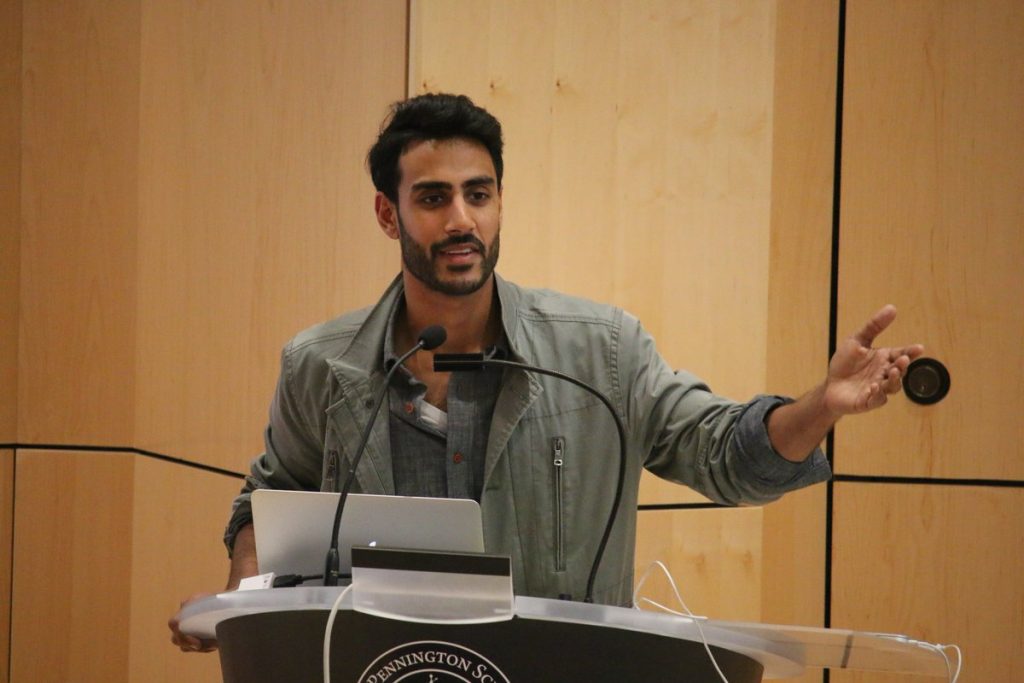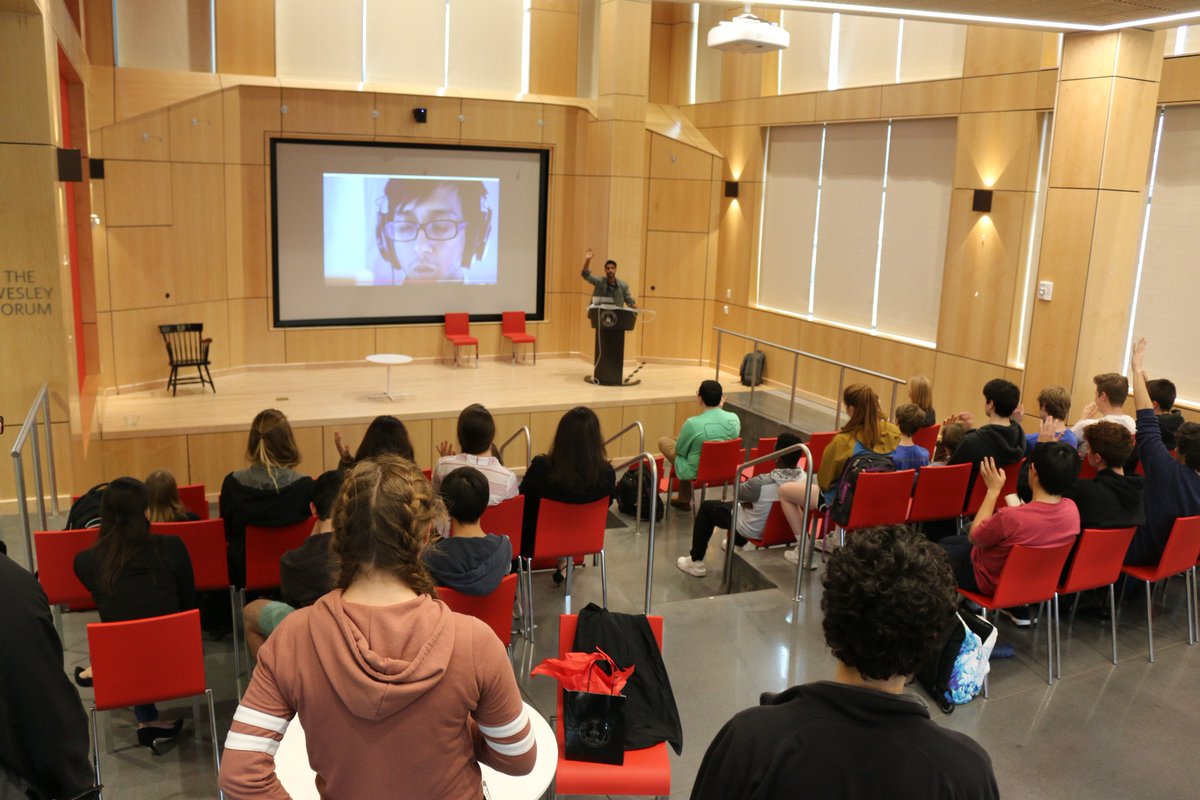This post was also published on Thrive Global.
I used to suck at public speaking. Whether I was in front of a small group of people, a boardroom or on a TED stage, having eyeballs glued to me while I presented was terrifying.
My first public speaking moment was a tragedy, and it was captured (for better or worse) on video, one which my parents have treasured for many years.
In the video, I was sitting in a chair in the center of my first-grade classroom surrounded by my classmates and teacher. We were there to present our craft projects that we spent the week building. There I was, tightly grasping onto my large wood butterfly that had messy globs of dried glue plastered everywhere, looking straight down at the wood floor and avoiding any eye contact. I was swinging my legs uncontrollably under the chair as the teacher probed for answers in an attempt to make me say something. Anything. When I eventually did speak, it was muttered, barely audible. Sensing that I wouldn't make any more progress, my teacher allowed me to return to my seat in the corner of the room.
This nervousness followed me throughout middle school, high school and well into college. I know it was holding me back from my potential.
Looking back, I can’t believe that was me.
Since I found meditation, which I've been practicing for many years now, it has had a significant impact on advancing my presentation technique further. And I believe it can for you as well.
Visualize Your Desired Outcome
Seeing really is believing. Visualizing a successful presentation can actually help you deliver one.
Visualization is a technique to create a mental image of a future event, and when we can visualize our desired outcome, we can begin to believe and "see" the possibility of achieving it. Social scientist Frank Niles explains how visualization works, "Visualization works because neurons in our brains, those electrically excitable cells that transmit information, interpret imagery as equivalent to a real-life action. When we visualize an act, the brain generates an impulse that tells our neurons to ‘perform’ the movement. This creates a new neural pathway — clusters of cells in our brain that work together to create memories or learned behaviors — that primes our body to act in a way consistent to what we imagined. All of this occurs without actually performing the physical activity, yet it achieves a similar result."
Take athletes, for example. According to humanistic psychologist Abraham Maslow, "Visualization helps the athlete just do it and do it with confidence, poise, and perfection. With repetition and concentration, guided imagery can be the athletes best asset towards winning any competition." All great sports legends including Michael Jordan, Larry Bird, Tiger Woods and pitcher Roy Halladay have used visualization to improve their performance and achieve their personal best.
Even Lindsey Vonn, Olympic Gold Medalist skier says, “I always visualize the run before I do it”, while literally moving her body in place as she pictures her descent down the course. “By the time I get to the start gate,” she reveals, “I’ve run that race 100 times already in my head, picturing how I’ll take the turns.”
So how can you use visualization to be an amazing presenter? Take 5 or 10 minutes to follow the steps below during your next meditation session:
- Relax: Find a quiet place, sit down and take a couple of deep breaths to let go of any tension in your body, and slowly close your eyes.
- Start imagining the stage: Begin to think about the room where you will be presenting. Is it dark? Bright? Who is in the audience? What are you wearing? Is it the morning or afternoon? Think about your environment until you have a clear and defined scene in your mind.
- First person view: Imagine looking at your audience, clicker in hand. Feel the air on your skin, and your voice as you go through your presentation like an expert. Focus on the how the audience will receive the information. How does the audience react after you are done? How do you want them to feel? How do you feel after giving a killer presentation?
- Wrap Up: Allow yourself to slowly come back. You completed your practice and the image slowly fades. When you are ready, open your eyes again.
Entering this mind state is super important, especially right before you get up in front of your audience.
Learn to Breathe Properly
Although the average human lung capacity is about 6 liters of air, we typically inhale much less. Oxygen is the most vital component we as humans need to live, yet it's fascinating how little of our lung capacity we actually use. Deep breathing, used in various meditative practices, helps get nourishing oxygen into your body. Blood that is rich in oxygen will help you feel better, give you more energy, reduce your anxiety and help clear your lungs.
Practice deep breathing not only regularly, but if you introduce it into your pre-presentation ritual, it could allow your mind to refocus before you step out in front of your audience.
Follow these simple steps for deep breathing:
- Take 3 deep breaths, filling your stomach, counting to 4
- Hold for 2 counts
- Release your breathe slowly, counting to 8
- Repeat 6-8 times
Remember, you’re less likely to get nervous when you take these intentional, deep breaths.
Allow Yourself to Become Nervous and Smile
Yup. On the day of your presentation, let yourself become a bit nervous. Just hear me out...
I will assume that you have done the due diligence of rehearsing your presentation, like any great speaker. But no matter how much prep you might have done, it's natural to feel a bit nervous. I still do, even after several years of giving presentations. I look at it positively, as a qualifier of sorts. I'm grateful that I have the privilege to even be giving a presentation, an opportunity that many people don't have. I allow myself the freedom to get nervous.
After acknowledging that I am getting a bit nervous, I smile. Smiling, even if you are consciously faking it, can improve your mood and reduce stress, which can be a great way to calm your nerves before hopping on stage. According to new research published in Psychological Science by Kansas researchers Tara Kraft and Sarah Pressman, people who smiled exhibited lower heart rate levels after completing a stressful task compared to subjects who assumed a neutral expression.
Smile because you got this! You've done the work and are ready to give a fantastic presentation!
Be Mindful and Read Your Audience
You're on stage. Everyone's eyes are on you. You have 60 seconds to capture your audience's attention, establish credibility, orient them on your topic and motivate them to listen, according to Darlene Price, president of Well Said, Inc., and author of Well Said! Presentations and Conversations That Get Results. There are some good strategies to help do that. But is there a way to read the audience in real-time to help you be more compelling in the delivery of your content?
The audience is constantly giving you non-verbal feedback that you can use. Here are a couple:
Body Language
About 55% of human communication is non-verbal, according to Dr. Albert Mehrabian, author of Silent Messages. That and includes facial expressions, gestures, posture, etc. When you are speaking, what is the audience doing? Are they checking their phones, slouching or tapping their feet? Or are they present, sitting upright and engaged?
Being able to be mindful of your audience on the fly and adjust your delivery can be an effective tactic to bring people back in. Some ways this could be done is to alternate volume and pitch while you speak, put more energy behind your delivery and maybe even call on a few members of the audience.
Eye Contact
When engaging with anybody, whether on stage or in a casual conversation, how we use eye contact plays a critical role in effective delivery. Our eyes are used to direct attention, connect, persuade, surprise and provide comedic relief.
If you've ever seen a bored, nearly asleep gaze in the audience, that is direct feedback you should be heeding. Some of the greatest speakers I have seen know how to connect directly with the audience, looking directly at their eyes. This helps the audience members invest their attention further into your material and you as a speaker. It also shows that you are confident and exude mastery over your material.
Reflection
What went right? What went wrong? Did you forget to say an important point? Reflection is probably the most important component in my personal speaking process, through which I've experienced the most growth and development as a speaker.
Take the time to have a conversation with yourself and relive your presentation in as much detail as you can remember. Put yourself back in front of the audience. Here are some tips to help get you started on your personal reflection:
- Write down the topic of your presentation and your desired intention for presenting
- Write down three things you did well in your presentation
- Write down three things you would like to improve on
- Reflect on whether you were able to successfully deliver on your intention
- Develop a plan to work on the points of improvement
This not only helps keep a record of your progress, but it reaffirms your intention and commitment to improve as a speaker.
Practice these simple tips and you will be well on your way to becoming an amazing presenter. Good luck!
Jesal Trivedi is the Founder and CEO of Aduri, a startup combining meditation mindfulness with IoT technology. He was the co-founder of the nationally recognized Tech808/The Phat Startup event series; Lead Product Manager at Blue Label Labs; an Innovation Consultant at The Medici Group; and is currently a Masters student at NYU ITP studying interactive technology.









